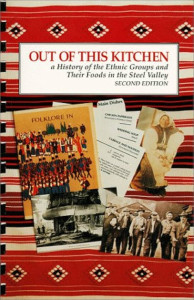 Food is part of the daily life of everyone, but the labouring class that worked in particularly dangerous occupations such as mining and steel making came to consider food more than something that you ate to keep going: food was a reminder of life beyond the hell hole you worked in.
Food is part of the daily life of everyone, but the labouring class that worked in particularly dangerous occupations such as mining and steel making came to consider food more than something that you ate to keep going: food was a reminder of life beyond the hell hole you worked in.
Out of This Kitchen: A History of the Ethnic Groups and Their Foods in Steel Valley includes African-Americans, Bulgarians, Germans, Hungarians, Irish, Italians, Jews, Poles, Macedonians, Russians, Scotch-Irish, Slovaks, and Ukrainians. It contains history, interviews and over 200 recipes, household tips and home remedies from newspapers dating back 100 years. It mixes brief but illuminating histories with recipes, creating an ethno-historical cookbook that celebrates the infamous lockout and strike of 1892 at the Carnegie Illinois Steelworks in Homestead, Pennsylvania.
It is the recipes that are the heart of the book (spiral-bound so you actually use it in your kitchen) as we can see in this recipe for Apple Dumplings from Homestead Local News for December 22, 1893:
Peel, core and cut up six ripe apples. Prepare a rich pastry, take small pieces of it, roll out and cut into slices about the size of a breakfast saucer. Into each put a teaspoonful of butter, two teaspoonfuls of sugar and two or three tablespoonfuls of minced apple. Form into balls by drawing the edges of crust together. Put them in a pan and sprinkle over the top a little sugar and some tiny pieces of butter. Cover with boiling water and bake, adding a little more water if it gets low before the dumplings are done.
You’ll also note that the recipe assumes you know how to “prepare a rich pastry” as every cook worth their salt in 1893 would have, and how big a “breakfast saucer” is.
It is without doubt the recipes that sell this book, though we must remember that Homestead was the place that the most bitter strike in American labour history took place — a strike that destroyed the American steel industry as a unionized force, but which also heralded the end of steel as an economic engine in America. Andrew Carnegie and the laborers in the steel mills both lost in the end. The Carnegie Illinois Steelworks in Homestead, Pennsylvania, would never recover from the actions of both sides in this strike. Carnegie Steel locked out 3,800 Amalgamated Association of Iron & Steel workers; workers barricaded themselves inside the plant and shut it down for five days. On July 6, Carnegie hired 300 armed Pinkertons with guns, dynamite, and cannon. The battle lasted all day and the Pinkertons surrendered with a total on both sides of 10 dead, over 60 wounded.
When they locked out men at Homestead
so they were face to face
With a lot of bum detectives
and they knew it was their place
To protect their homes and families,
and this was neatly done
And the public will reward them
for the victories they won.
(Publassist, 1998)
